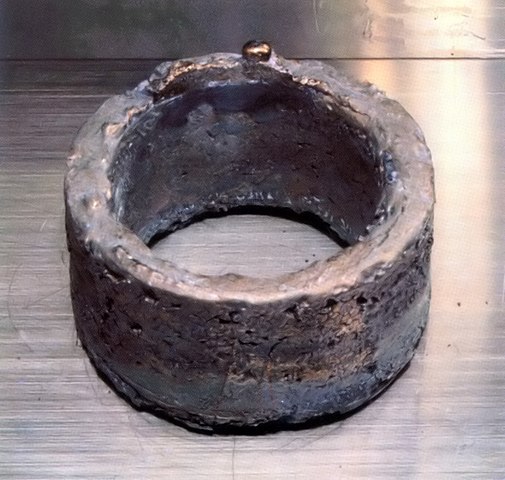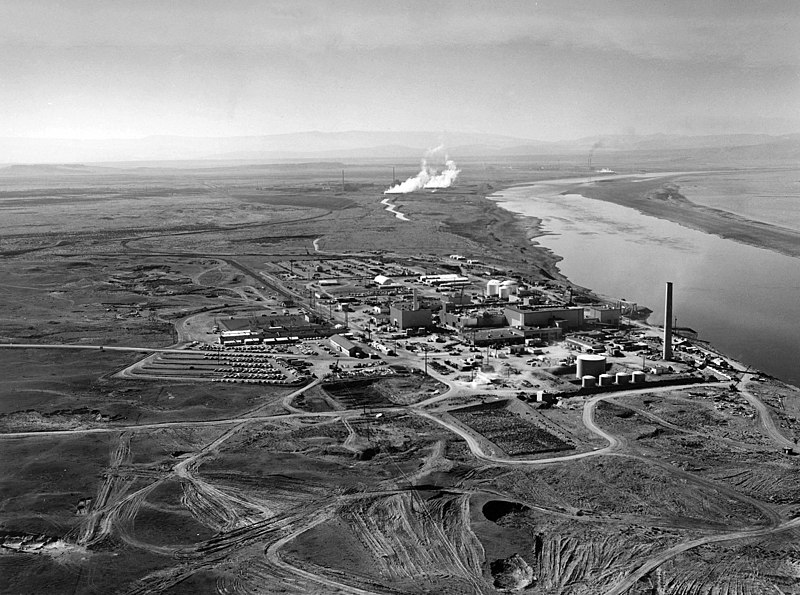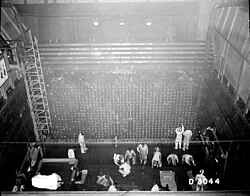A weapons-grade ring of electrorefined plutonium, typical of the rings refined at Los Alamos and sent to Rocky Flats for fabrication
. Source. The ring has a purity of 99.96%, weighs 5.3 kg, and is approx 11 cm in diameter. It is enough plutonium for one bomb core. Which city shall we blow up today?Ciro Santilli is mildly obsessed by nuclear reactions, because they are so quirky. How can a little ball destroy a city? How can putting too much of it together produce criticality and kill people like in the Slotin accident or the Tokaimura criticality accident. It is mind blowing really.
More fun nuclear stuff to watch:
- Dr. Strangelove (1964)
- en.wikipedia.org/wiki/Chernobyl_(miniseries)
- The World Of Enrico Fermi by Harvard Project Physics (1970)
- Fat Man and Little Boy (1987) shows a possibly reasonably realistic of the history of the development of the Trinity
The Ultimate Guide to Nuclear Weapons by hypohystericalhistory (2022)
Source. Good overall summary. Some interesting points:- youtu.be/8uIPQBOCJ64?t=2946 talks about the difference between tactical and strategic nuclear weapons
- youtu.be/8uIPQBOCJ64?t=3291 mentions variable yield devices, this is the main new thing Ciro Santilli learned from this video
- youtu.be/8uIPQBOCJ64?t=3416 discusses if a strategic nuclear weapon usage would inevitably lead to tactical nuclear weapon escalation. It then mentions one case in which a possibly comparable escalation didn't happen: the abstinence of using chemical weapon during World War II.
Gun-type fission weapons are the simplest approach and they work with Uranium-235 bombs as you can ignite it with just one explosion.
But Gun-type fission weapons don't work with plutonium, and weapon grade Plutonium is cheaper than weapon grade Uranium, so it wasn't much used.
Gun-type fission weapons don't work with Plutonium-239 because of the presence of Plutonium-240 as an impurity which leads to fizzle.
Good mentions at: youtu.be/dgBDvnqMkT4?t=252
Implosion-type fission weapons are more complicated than gun-type fission weapon because you have to precisely coordinate the detonation of a bunch of explosives.
Oppenheimer's Gamble by Welch Labs
. Source. Fails to mention Plutonium-240 as the source of the problem.- youtu.be/W06g7gIfwRE?t=252 cool to learn that the explosive lenses had to be made out of two different types of explosives, slow and fast, to be more symmetrical
Production is fully concentrated at Los Alamos National Laboratory in the United States as of 2020. TODO was it ever made anywhere else?
For nuclear weapons you need a certain level of isotope purity of either plutonium-239 or uranium-235.
And the easiest way by far to achieve this purity is to produce plutonium-239 in a breeder reactor, which allows you to get it out with much cheaper chemical processes rather than costly isotope separation methods.
sgp.fas.org/othergov/doe/pu50yc.html mentions:That site also contains a good summary of the closed shutdown reactors in each site. These are publicly disclosed e.g. at: www.hanford.gov/page.cfm/ProjectsFacilities
The United States Government has used 14 plutonium production reactors at the Hanford and Savannah River sites to produce plutonium for the U.S. nuclear weapons stockpile and DOE research and development programs. From 1944 to 1994, these reactors produced 103.4 metric tons of plutonium; 67.4 MT at Hanford, and 36.1 at Savannah River.
www.youtube.com/watch?v=qwKhz7BPBLY mentions that before they stopped production at the end of the Cold War, Hanford site produced 2/3 of the total American stockpile, and Savannah River site produced 1/3.
www.reuters.com/article/world/americas-nuclear-headache-old-plutonium-with-nowhere-to-go-idUSKBN1HR1JT/ claims that as of 2018 Savannah River site stored the majority of the stockpile.
Bibliography:
nct-cbnw.com/americas-new-nukes-plutonium-pits-at-los-alamos/
After the closure of the country’s prime plutonium manufacturing plant at Rocky Flats in 1992, where 1,000 to 2,000 pits were produced every year, a highly reinforced 236,000 sq-ft facility built at LANL earlier in 1978 became the first Department of Energy (DoE) facility capable of producing plutonium cores.Although initially established for plutonium research and development, in 2003 the Plutonium Facility Building 4 (PF-4) within Tech Area 55 at Los Alamos produced the nation’s stockpile quality (first war reserve) plutonium. In 2006, Congress instructed the DoE to focus on producing pits at this facility.
The B Reactor of the facility produced the plutonium used for Trinity and Fat Man, and then for many more thousand bombs during the Cold War. More precisely, this was done at
Located in Washington, in a dry place the middle of the mountainous areas of the Western United States, where basically no one lives. The Columbia river is however nearby, that river is quite large, and provided the water needed by their activities, notably for cooling the nuclear reactors. It is worth it having look on Google Maps to get a feel for the region.
Unlike many other such laboratories, this one did not become a United States Department of Energy national laboratories. It was likely just too polluted.
Bibliography:
This was the first full scale nuclear reactor in the world, and was brought up slowly to test it out.
Hanford B Reactor tour by Studio McGraw
. Source. 2016.- youtu.be/8rlVHEY7BF0?t=335 good description of the fuel element. It uses uranium metal, not Uranium dioxide
- youtu.be/8rlVHEY7BF0?t=652 N Reactor and F Reactor were identical, and came up 2 months later, but much faster because of what they learned on the B
This was one of the two American plutonium production sites, together with the Hanford site. www.youtube.com/watch?v=qwKhz7BPBLY mentions it produced about 1/3 of the total American plutonium.
www.reuters.com/article/world/americas-nuclear-headache-old-plutonium-with-nowhere-to-go-idUSKBN1HR1JT/ claims that as of 2018 it stored the majority of the plutonium stockpile of the country.
It's where most American nuclear weapons are assembled and disassembled.
Dismantlement of Nuclear Weapons by Sandia National Laboratories
. Source. Great video, shows everything that is not classified.Historic, unique Manhattan Project footage from Los Alamos by Los Alamos National Lab
. Source. Mostly the daily life part of things, but very good, includes subtitles explaining the people and places shown.
Marked with identifier "LA-UR 11-4449".
Getting funding for the Chicago Pile Edward Teller interview by Web of Stories (1996)
Source. - youtu.be/mnScq24BEmc?t=114 the main cost for the reactor was the graphite. Presumably they already had the uranium in hand?. Edit, no, it is because it was a specialized graphite: Video 2. "German graphite from The Genius Behind the Bomb (1992)", i.e. nuclear graphite.
German graphite from The Genius Behind the Bomb (1992)
Source. Graphite was expensive because it had to be boron-free, since boron absorbs neutrons. But a boron process was the main way to make graphite. This type of pure graphite is known as nuclear graphite.The lab that made Chicago Pile-1, located in the University of Chicago. Metallurgical in this context basically as in "working with the metals uranium and plutonium".
Given their experience, they also designed the important X-10 Graphite Reactor and the B Reactor which were built in other locations.
Plutonium-based.
Its plutonium was produced at Hanford site.
Trinity: Getting The Job Done
. Source. Good video, clarifies several interesting technical points:- Gun-type fission weapon were much easier to build as you don't need super synchronized charges as in implosion-type fission weapon. But they are less efficient.
- Plutonium make much more efficient usage of uranium, because you don't need to highly enrich a bunch of Uranium-235 in the first place, but rather just use way less enriched Uranium-235 to produce a bunch of Plutonium by converting Uranium-238
Their website, and in particular the recruitment section, are so creepy.
There's not mention of bombs. No photos of atomic explosions. The words "atomic" and "weapon" do not even show up in the front page!!! The acronym AWE is instead used everywhere as an euphemism.
In the recruitment section we can see a bunch of people smiling: web.archive.org/web/20211007213222/https://www.awe.co.uk/careers/working-at-awe/, suggesting:There's even children outreach!!!
Ciro Santilli is not against storing a few nukes to be ready against dictatorships. But don't be such a pussy! Just say what the fuck you are doing more clearly! You are making weapons to kill people and destroy things in order to maintain the Balance of power. If the public can't handle such facts, then shut down the fucking program.
Atomic Weapons Establishment by The Gwent Auditor
. Source. Dude walking around the public area filming. Got stopped by police to make sure he didn't do anything he shouldn't.Knock knock.
Missileers by BBC (2000)
Source. Documentary about American ICBM crews working on the Francis. E. Warren Air Force Base. Wiki mentions that there are 3 main sites in the USA, and plainshumanities.unl.edu/encyclopedia/doc/egp.ii.042 suggests all/most of them are in the Great Plains area. They operate a Minuteman system, which as of 2021 is the only nuclear ICBM system in the USA.
Good documentary, shows well the day-to-day life of the operator, including outside of the work site.
- youtu.be/w1tMx27Q4O0?t=1390 they drive 100 miles to get to work. They do 8 alerts per month.
- youtu.be/w1tMx27Q4O0?t=1473 the actual missiles are a few miles away from the control center, scattered in a few different locations
- youtu.be/w1tMx27Q4O0?t=1619 they have a television in there at least. Presumably a pre-recorded selection.
Logistics support management by USAF
. Source. Shows logistic operations behind the American ICBM system of the time. Reuploaded to showcase the IBM 705 system used to track parts, notably the usage of a punch cards.alcpress.org/military/icbm/index.html has a Google Maps overlay with all of the American ICBM sites, spread out across three centers. It is cute to see how they are very evenly spread out to make it hard to take them out at once.
uploads.fas.org/sites/4/NotebookMap.pdf summarizes all ICBM and also other delivery methods as of 2006.
Ah, the choice of name, both grim and slightly funny, Dr. Strangelove comes to mind quite strongly. Also Fallout (franchise).
- youtu.be/VTQ8yZSyrC0?t=75 map of missile silos
- youtu.be/VTQ8yZSyrC0?t=210 shows a map of the communication copper wires linking up a silo farm. Presumably Hardened Intersite Cable System
Bibliography:
Ciro Santilli's jaw dropped when he learned about this concept. A Small Talent for War, are you sure?
plutonium-based.
Its plutonium was produced at Hanford site.
Articles by others on the same topic
A nuclear weapon is a device that releases energy in an extremely powerful explosion as a result of nuclear reactions, either fission (the splitting of atomic nuclei) or fusion (the combining of atomic nuclei). These weapons are capable of causing massive destruction and loss of life. **Types of Nuclear Weapons:** 1. **Fission Bombs (Atomic Bombs):** These weapons work by splitting heavy atomic nuclei, such as uranium-235 or plutonium-239, into smaller nuclei.










